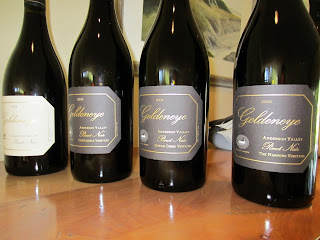The Anderson Valley suffers somewhat from isolation, as every road into it is very windy and narrow (which makes for great driving, actually). There isn't a large population living there either, so drawing people in is very important. Luckily they are blessed with some of the best fruit in California, both wine grapes and table fruit like apples. Post-Prohibition this region was established until the early '70s and so they are younger than most regions in the state. The key varieties here are pinot noir (the best in California in my opinion), and gewurtztraminer.
 |
| Tasting at Goldeneye Winery |
 |
| Goldeneye range |
Goldeneye Winery has no relation to James Bond whatsoever, just to clarify. After establishing wineries in the Napa Valley, Dan and Margaret Duckhorn decided to explore the potential of pinot noir, and chose the Anderson Valley to do it. Since the first commercial vintage in 2000, Goldeneye wines have established themselves for being world-class expressions of site and variety. Having tasted through the range which includes a sub-label, an estate wine and three single vineyard wines, I can see why they are so sought after. I can say with some confidence these were the best pinot noirs I tasted in California. They walk in ballet shoes on the tightest thread between too light and too heavy, too much fruit and too much savoury. They are so well balanced and delicate you could be forgiven for thinking they were simple. Whilst cabernet has a structure similar to that of steel girders, these pinots have an almost spider-web like structure, so fine but so strong. The wines are also my preference for enjoying with food, as I tend to go for more Cote-de-Beaune style than Cote-de-Nuits. Simply a revelation.
 |
| Lula range |
Further up the valley was Lula, only in it's second vintage and very small (1300 cases). The wines here showed a lot of potential, and I tried the first of many pinot noir roses for the day. The zinfandel was very good, but the pinot was a little extracted and hot. Next door was Drew Wines which had been recommended to me by several people. Unforunately they were closed, even though the sign said open Thursdays to Mondays. Busy time I guess, vintage and all. Not far away was Toulouse Winery, named after the breed of goose, not the town in France or the 19th Century French artist. Whilst the new tasting room is being finished, they are conducting tastings in the winery, right next to fermenting pinot noir. The gewurtztraminer was the best wine here, but the pinots were pretty good too.
 |
| Pinot noir ferments at Toulouse |
Back in 1974 when there were only two wineries in the Anderson Valley, Navarro Vineyards and Winery planted their first gewurtztraminer vines, seeing the potential for Alsatian varieties. They take risks and do some interesting things here, including blending riesling, gewurtztraminer, pinot gris and muscat into a traditional Alsatian style. When you taste the wines you can see what the family saw nearly 40 years ago. The second winery to establish in the Valley was Husch Vineyards, also planting gewurtztraminer and pinot noir back in 1972. The wines aren't as good, but they do have some variety and the sweet wines are very nice.
 |
| Navarro tasting room |
 |
| Gewurztraminer vines at Husch Vineyards |
A number of people had suggested visiting Roederer Estate, established by the champagne house in 1982, as they produce the best sparkling wine in California. Whilst the fruit character was undeniably California in style, the yeast autolysis is much better integrated than other sparkling wines I have tried. Interestingly this was very pronounced when comparing the 750ml Brut MV and the magnum of the same wine. The vintage wines had great elegance and balance, but the still wines were probably the most insipid I have tried. They would be better used as base wines for the sparkling wines.
 |
| Roederer Estate Jeraboam |
Click
here to see more photos from Day Two of Mendocino County.







No comments:
Post a Comment